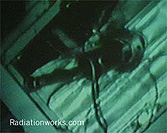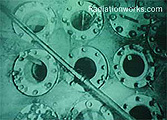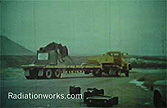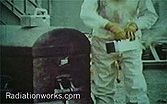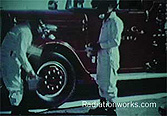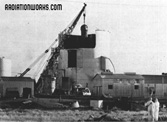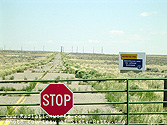
|
The world's first fatal atomic accident occurred on January 3, 1961 when a small, 3MW experimental BWR called SL-1 (Stationary Low-Power Plant No. 1) in Idaho was destroyed after a control rod was removed manually. At 9:01pm, alarms sounded at the fire stations and security headquarters of the U.S. National Reactor Testing Station where the reactor was located. Investigation found two operators dead (third died later), and detected high radiation levels in the building. A careful examination of the remains of the core and the vessel concluded that the control rod was manually withdrawn by about 50 centimeters (40 centimeters would have been enough to make the reactor critical), largely increasing the reactivity. The resulting power surge caused the reactor power to reach 20,000MW in about .01 seconds, causing the plate-type fuel to melt. The molten fuel interacted with the water in the vessel, producing an explosive formation of steam that caused the water above the core to rise with such force that when it hit the lid of the pressure vessel, the vessel itself rose 3 meters in the air before dropping back down. The SL-1 accident was the
first fatal nuclear accident in the United States. The men killed
in the incident were two Army Specialists, John Byrnes, age 25 and Richard
McKinley, age 22, and Richard Legg, a 25 year old Navy Electricians Mate.
Richard McKinley was interred in Arlington National Cemetery. John
Byrnes and Richard Legg were buried in their hometowns in New York and
Michigan.
As quoted by Arlington National Cemetary Records: "3 January 1961: A reactor explosion (attributed by a Nuclear Regulatory Commission source to sabotage) at the National Reactor Testing Station in Idaho Falls, Idaho, killed one navy technician and two army technicians, and released radioactivity "largely confined" (words of John A. McCone, Director of the Atomic Energy Commission) to the reactor building. The three men were killed as they moved fuel rods in a "routine" preparation for the reactor start-up. One technician was blown to the ceiling of the containment dome and impaled on a control rod. His body remained there until it was taken down six days later. The men were so heavily exposed to radiation that their hands had to be buried separately with other radioactive waste, and their bodies were interred in lead coffins." From the Arlington National Cemetary Records: HEADQUARTERS SUBJECT: Internment of Radioactive Remains TO: Superintendent 1. Radioactive remains of SP4 Richard L. McKinley were interred at Arlington National Cemetery on 25 January 1961. 2. It is desired that the following remark be placed onthe permanent record, DA Form 2122, Record ofInternment: "Victim of nuclear accident. Body is contaminated with long-life radio-active isotopes. Under no circumstances will the body be moved from this location without prior approval of the Atomic Energy Commission in consultation with this headquarters." FOR THE COMMANDER: Leon S. Monroe, II See also: Idaho National Engineering Laboratory
|



